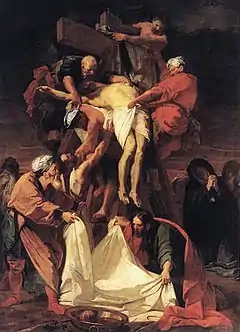Sindon (cloth)
Sindon, also known as Syndone, was a fine cloth that resembled muslin or cambric. It had multiple applications, including as a material used in furnishing, covering the pyx, and was referenced in the Bible and ancient Greek literature. According to Christian tradition, it was Sindon cloth in which the body of Jesus of Nazareth was shrouded.
History
Sindon was an ancient Babylonian textile primarily made from linen. There are varying accounts of the texture and material, with some sources indicating cotton, linen, and silk. Sindon presents a source of confusion in various contexts. Certain scholars have interpreted this term to refer to dyed cotton fabrics. It was also alternatively known as 'Syndone' and held the transitional designation of 'cendel,' which had associations with silken materials.[1] Records of exports from England in 1382 indicate that Sindon was a type of silk material.[1] Sindon cloth has been produced in Sindh, Pakistan, since before the Christian era, and was exported to Mediterranean countries.[2][3]
Sindon was also used for interior decoration. Sindon cloth curtains in green were used to decorate King Edward's chamber according to historical records of his wardrobe.[4]
Christianity

References to 'Sindon' cloth can also be found in both the Bible and ancient Greek literature.[5][6] According to Christian tradition, Sindon cloth was used to shroud the body of Jesus.[7]: 509 The Shroud of Turin, which is purported to be Jesus's burial shroud, is a rectangular piece of sindon fabric that measures approximately 4.36 metres (14.3 ft) in length and 1.1 metres (3 ft 7 in) in width. It displays a faint, sepia-toned image of a man's front and back, with wounds consistent with crucifixion.[8]
Aldred the Glossator, a 10th-century priest, offered an explanation for the term "sindon" (i.e., "shroud" or "fine linen cloth"), but he provided this clarification specifically where the word is used to refer to the burial shroud of Jesus in passages such as MtGl(Li) 27.59, MkGl(Li) 15.46, and LkGl(Li) 23.53.[9] Sindon cloth was considered sacred and had multiple uses, such as being used to cover the pyx.[10] Prominent historical relics in Suffolk include the 'Sindon cloth', used to cover the pyx containing the reserved Blessed Sacrament, and the 'burse', a case designed for the corporal upon which the Host is placed during Mass. Both of these items originated from the Hessett church in Suffolk and are currently on loan to the British Museum.[10]
See also
- Burial of Jesus
- History of the Shroud of Turin
- Christianity in the ante-Nicene period
- Acheiropoieta
- Church tabernacle
- Matthew 27:59
References
- Manufacturers, National Association of Wool (1895). Bulletin. p. 157. Archived from the original on 2023-10-12. Retrieved 2023-09-02.
- Grassroots. Pakistan Studies Centre, University of Sind. 2006. p. 11. Archived from the original on 2023-10-12. Retrieved 2023-09-01.
- Planché, James Robinson (2003-01-01). An Illustrated Dictionary of Historic Costume: From the First Century B.C. to C. 1760. Courier Corporation. p. 463. ISBN 978-0-486-42323-4. Archived from the original on 2023-04-12. Retrieved 2023-09-01.
- Warr, Cordelia (2023-07-04). Medieval Clothing and Textiles 17. Boydell & Brewer. pp. 82, 83. ISBN 978-1-78327-598-4. Archived from the original on 2023-10-12. Retrieved 2023-09-02.
- Black, Carolyn (2003). Pakistan : the land. Internet Archive. New York : Crabtree Pub. Co. p. 27. ISBN 978-0-7787-9346-5.
- Pakistan: A Travel Survival Kit. Lonely Planet Publications. 1993. p. 105. ISBN 978-0-86442-167-8. Archived from the original on 2023-10-12. Retrieved 2023-09-01.
- Oxford English Dictionary
- Adler, Alan D. (2014-01-01). The Orphaned Manuscript: A Gathering of Publications on the Shroud of Turin. Effata Editrice IT. p. 35. ISBN 978-88-7402-003-4. Archived from the original on 2023-10-12. Retrieved 2023-09-02.
- Cuesta, Julia Fernández; Pons-Sanz, Sara M. (2016-03-21). The Old English Gloss to the Lindisfarne Gospels: Language, Author and Context. Walter de Gruyter GmbH & Co KG. p. 354. ISBN 978-3-11-044910-5. Archived from the original on 2023-10-12. Retrieved 2023-09-02.
- Change and decay : the future of our churches. Internet Archive. London : Studio Vista. 1977. p. 17. ISBN 978-0-289-70774-6.
{{cite book}}: CS1 maint: others (link)
